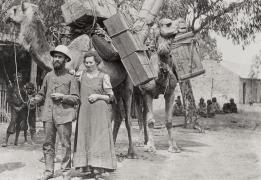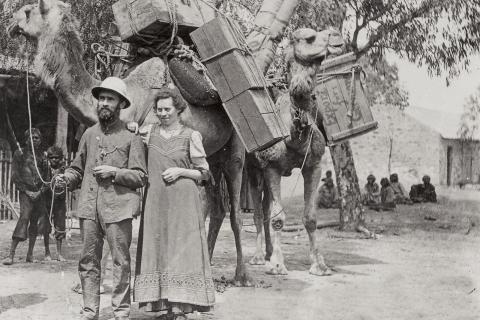This building is the oldest surviving residence at Hermannsburg. It was built in 1885 for the married lay workers. Families who lived here included the Juergens, Baden and Koch families, and missionary Liebler. These colonists were Lutheran lay workers engaged under Theodor Harms scheme for missions in remote places. The idea behind this was to send workers with useful skills such as carpentry and stock breeding who would be able to help the mission become self-sustaining Christian communities. These lay workers were paid very little in the way of wages or stipend. The Lutheran church believed that the pastors and colonist should be married and set an example of pious family life, unfortunately, the experiences of many of these husbands and wives is not well documented and one is left to imagine how they struggled with life in Central Australia so far from their home country.
In 1894, when Mr. Winnecke visited the then partially abandoned mission, he described the building as a “substantially built stone house of 7 rooms, sandstone walls, 1’3” (38cm) in thickness, thatch roof, and verandah-post and rail fence”. The current verandah, however, is a later addition built in 1917 by Arthur Latz who used desert oak posts which are termite resistant, and a pebble and mortar floor. The building itself is constructed of lime rendered sandstone rubble with a lime wash coating with a bush timber and corrugated iron roof and flagstone floors. A section of the internal wall has been exposed to demonstrate some of the methods used to construct the Mission buildings, including the fachwerkbau – half-timbering technique of construction that was the most popular building style in Germany in the 14th century and remained so until the beginning of the 19th century.
In addition to housing various families the building was also used for a time as the schoolroom for Aboriginal children.
The dreams of a self-sufficient Lutheran colony
The colonists that built and inhabited this building arrived from Germany and accompanied the first missionaries: Herman Kempe and Wilhelm Schwarz. More colonists arrived a few years later with missionary Louis Schulze. The idea was that the mission would eventually become a self-sufficient and thriving settlement and so there was an emphasis on practical skills. In fact, Kempe was previously a blacksmith and Schwarz was a baker before they were ordained.1
The weather and conditions took a heavy toll on the earliest missionaries. Kempe wrote several times to Pastor Harms back in Germany informing him that the climate was robbing them of their strength. Illness dogged them and in 1888-89 an outbreak of influenza, followed quickly by a typhoid outbreak sounded the death knell of the fledgling colony.
Schwarz left Hermannsburg to return southward exhausted and ill. Schulze lasted until October 1891, at which time he was also forced to leave due to ill health. Kempe’s wife and one of their 5 children died and he was forced to leave with his remaining children a broken man. After this, although a few colonists tried to keep the place going they eventually gave up and the mission was abandoned by the settlers until the Immanuel Synod took ownership of the property in late 1984.
- Tampke, Jurgen 2006 The Germans in Australia. Cambridge University Press.
Media






